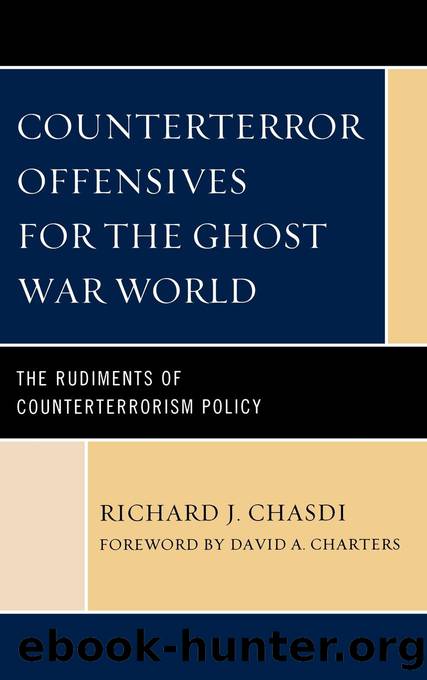Counterterror Offensives for the Ghost War World by Chasdi Richard J.;

Author:Chasdi, Richard J.;
Language: eng
Format: epub
Publisher: Lexington Books
Published: 2010-08-15T00:00:00+00:00
Chapter 5
The Case of Counterterror in Authoritarian
Democracies and an Authoritarian Regime:
Basic Contours of the Counterterror
Practices of Three Nation-States
Introduction
The purpose of this second chapter of the data analysis is to present findings for counterterror practices that operate within the context of political systems which are not examples of western style liberal democracies. The first objective is to present and interpret a set of empirical findings about the contours of counterterror practices for two nation-states that are âauthoritarian democracies,â namely the Russian Federation and Turkey. The second objective is to present and interpret empirical findings for an âauthoritarianâ system, namely Peru, for the time that President Alberto Fujimori was at the helm of state between 1990 and 2000. Peru was selected as a case study because of the rich data set available as a consequence of concerted and sustained terrorism carried out by the two primary Peruvian terrorist groups active in the political fray at that time. Those two terrorist organizations were the Shining Path, otherwise known as Sendero Luminoso, and the Tupac Amaru Revolutionary Movement, otherwise known as the Movimento Revolucionario Tupac Amaru or MRTA. From the start, it should be clear that since the âauthoritarianâ system category is represented by only one case study, the findings are not definitive, but merely more suggestive of what counterterror practices within the context of âauthoritarianâ systems are all about.
When democracy is described, one underlying theme that is commonplace to note is that democracy varies according to the political and social settings in which it is found. In the broader sense, the central notion is that there is no one particular blueprint for the structural shape of democratic government and institutions. For Dahl, that idea traces an arc back to Aristotleâs writings in his work, The Politics. As Dahl tells us, Aristotle is one of the âmild adversariesâ of democracy, and it is Aristotle himself who describes five different types of democratic systems that can be distinguished from one another based on several different characteristics. Those characteristics include a political condition where âthe law is the final sovereign,â by contrast to a condition whereby âthe people . . . is the final sovereign.â For Aristotle, other defining characteristics of that âdemocratic constitutionâ include the heritage or âdescentâ of the âcitizen,â and a set of âproperty qualificationsâ that might be necessary in order for a âcitizenâ in a democracy to acquire political office.1
At a functional level, one way of thinking about the structural shape of the âauthoritarian democracyâ framework revolves around the notion of centralization, and the imposition by the ruling political elite of acute constraints on certain aspects of the democratic process. Such constraints are oftentimes couched as a necessary condition essential to preserve the integrity of the state, or its national security interests, or both. Those constraints include, but are not necessarily limited to, the constraint of civil liberties which are sacrosanct in western style liberal democracies, such as the right to assemble, religious preference and practice, and freedom of speech. In addition,
Download
This site does not store any files on its server. We only index and link to content provided by other sites. Please contact the content providers to delete copyright contents if any and email us, we'll remove relevant links or contents immediately.
Spell It Out by David Crystal(35852)
Life for Me Ain't Been No Crystal Stair by Susan Sheehan(35539)
Cecilia; Or, Memoirs of an Heiress — Volume 1 by Fanny Burney(32067)
Cecilia; Or, Memoirs of an Heiress — Volume 3 by Fanny Burney(31463)
Cecilia; Or, Memoirs of an Heiress — Volume 2 by Fanny Burney(31413)
The Great Music City by Andrea Baker(30794)
Professional Troublemaker by Luvvie Ajayi Jones(29425)
We're Going to Need More Wine by Gabrielle Union(18640)
Twilight of the Idols With the Antichrist and Ecce Homo by Friedrich Nietzsche(18304)
The Secret History by Donna Tartt(18188)
Cat's cradle by Kurt Vonnegut(14768)
All the Missing Girls by Megan Miranda(14766)
Pimp by Iceberg Slim(13787)
Bombshells: Glamour Girls of a Lifetime by Sullivan Steve(13691)
Fifty Shades Freed by E L James(12923)
Talking to Strangers by Malcolm Gladwell(12887)
Norse Mythology by Gaiman Neil(12847)
The Social Justice Warrior Handbook by Lisa De Pasquale(11957)
Underground: A Human History of the Worlds Beneath Our Feet by Will Hunt(11842)
